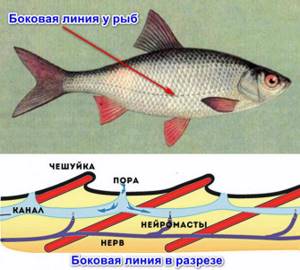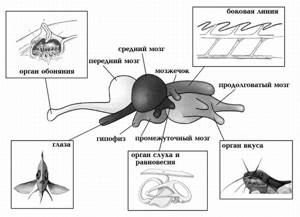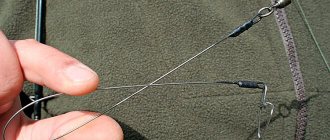Organ of vision
Vision is one of the main sense organs in fish. The eye consists of a round shaped lens that has a hard structure. It is located near the cornea and allows you to see at a distance of up to 5 m at rest, maximum vision reaches 10-14 m.
Structure of a fish's eye
The lens captures many light rays, allowing you to see in several directions. Often the eye has an elevated position, so it receives direct rays of light, oblique, as well as from above, below, and from the sides. This significantly expands the fish’s field of vision: in the vertical plane up to 150°, and in the horizontal plane up to 170°.
Monocular vision - the right and left eyes receive a separate image. The eye consists of three membranes: the sclera (protects from mechanical damage), the vascular (supplies nutrients), and the retinal (provides light perception and color perception due to the system of rods and cones).
Hearing organ
The hearing aid (inner ear or labyrinth) is located in the back of the skull and includes two compartments: the upper oval and round lower sacs. The oval sac contains three semicircular canals - this is an organ of balance; endolymph flows inside the labyrinth; in cartilaginous fish it connects with the environment through the excretory duct; in bony fish it ends blindly.

The organ of hearing in fish is combined with the organ of balance.
The inner ear is divided into three chambers, each containing the otolith (part of the vestibular apparatus that responds to mechanical stimulation). The auditory nerve ends inside the ear, forming hair cells (receptors); when the position of the body changes, they are irritated by the endolymph of the semicircular canals and help maintain balance.
The perception of sounds is carried out due to the lower part of the labyrinth - a round sac. Fish are able to detect sounds in the range of 5Hz – 15kHz. The hearing aid includes the lateral line (allows you to hear low-frequency sounds) and the swim bladder (acts as a resonator, connected to the inner ear through the Weberian apparatus, consisting of 4 bones).
Fish are myopic animals, they often move in muddy water, with poor lighting; some individuals live in the depths of the sea, where there is no light at all. What sense organs and how do they allow one to navigate in water under such conditions?
A little theory about the essence of sound

Physicists have long established that sound is nothing more than a chain of regularly repeating compression waves of a medium (air, liquid, solid). In other words, sounds in water are just as natural as on its surface. In water, sound waves, the speed of which is determined by the compression force, can propagate at different frequencies:
- most fish perceive sound frequencies in the range of 50-3000 Hz,
- vibrations and infrasound, which refer to low-frequency vibrations up to 16 Hz, are not perceived by all fish,
- are fish capable of perceiving ultrasonic waves whose frequency exceeds 20,000 Hz) - this question has not yet been fully studied, therefore, convincing evidence regarding the presence of such an ability in underwater inhabitants has not been obtained.
It is known that sound travels four times faster in water than in air or other gaseous media. This is the reason that fish receive sounds that enter the water from outside in a distorted form. Compared to land dwellers, fish's hearing is not as acute. However, experiments by zoologists have revealed very interesting facts: in particular, some species of slaves can distinguish even halftones.
Side line
First of all, this is the lateral line - the main sensory organ in fish. It is a channel that runs under the skin along the entire body and branches in the head area, forming a complex network. It has holes through which it communicates with the environment. Inside there are sensitive kidneys (receptor cells) that perceive the slightest changes around.
This way they can determine the direction of the current, navigate the area at night, and sense the movement of other fish, both in a school and of predators approaching them. The lateral line is equipped with mechanoreceptors; they help aquatic inhabitants to dodge pitfalls and foreign objects, even in poor visibility.
The lateral line can be complete (located from the head to the tail), incomplete, or can be completely replaced by other developed nerve endings. If the lateral line is injured, the fish will no longer be able to survive for long, which indicates the importance of this organ.

The lateral line of fish is the main organ of orientation
Ultrasound conversation
The range of human auditory perception is quite wide - between 16 Hz and 20 kHz, although with age our sensitivity to high frequencies decreases. A person is maximally susceptible to the so-called “speech frequencies”, 1-3 kHz.
Most fish are sensitive to sounds in a narrower and lower frequency region: in the range from hundreds of hertz to 5-6 kHz (Smith et al
., 2011).
But in a number of other aquatic vertebrates, the range of frequencies perceived by the hearing aid expands into the ultrasonic region, for example, in open-vesical fish
, in which the hearing aid is connected by three pairs of movably connected bones to
the swim bladder
- an outgrowth of the anterior part of the intestine filled with gas.

In particular, the Atlantic herring is capable of perceiving and emitting ultrasound with a frequency of up to 180 kHz (!), and it comes out of the anus of the fish along with air (Mann et al
., 1998;
Plachta et al
., 2004). The dolphin, the main consumer of herring, is also capable of producing and capturing sounds of a similar frequency, although the nature of its sound production is less bizarre. It is by ultrasonic signals that this predator determines the location of its prey. Herring, in turn, is able to recognize an approaching dolphin by the sound signals it makes when hunting, and, showing a defensive reaction, escape from danger.
The common and well-known Atlantic herring is capable of emitting and receiving ultrasound in the kilohertz (up to 180 kHz) range! It is believed that in humans, ultrasound at high frequencies can cause overheating of internal organs, burns and dehydration of tissues and their micro-tears as a result of cavitation (formation of gas bubbles)
Similar examples of acoustic behavior can be found among Baikal endemics - unique inhabitants of the freshwater “sea”. Nowadays, special attention is paid to studying the acoustic behavior of Baikal seals. In fact, these pinnipeds perceive sounds from low (about 100 Hz) frequencies to ultrasonic frequencies of 30 kHz (Kastak and Schusterman, 1998; Cunningham and Reichmuth, 2016).
The hearing abilities of endemic Baikal fish are largely determined by the presence or absence of a swim bladder (Sapozhnikova et al
., 2021, 2017).
Thus, all Baikal sculpin gobies from the suborder of slingshot fish
(Cottoidei), including the well-known golomyanka, do not have a swim bladder, which indicates their origin from bottom forms.
The maximum of their auditory sensitivity lies in a lower frequency range (300-700 Hz) compared to bladder whitefishes
from the family Coregonidae (for example, Baikal omul) with an auditory range of 400-1500 Hz.

Speciation of Baikal whitefishes and slingshot fishes is a unique example of different evolutionary mechanisms that “worked” in the same body of water with very different environmental conditions. Whitefishes are characterized by low species diversity (only three species), but within them different populations, subpopulations and morpho-ecological groups (coastal, pelagic, deep-sea) can be distinguished, each with corresponding adaptations to living in certain environmental conditions. Slingshot fish have adapted to life in Baikal by forming a whole “bouquet” of three to four dozen species, distinguished by their narrow specialization.
The main burden when adapting to a certain ecological niche falls on sensory systems that are in contact with the external environment and must respond to its slightest changes. And due to their ecological similarity, Baikal fish serve as an excellent object in the search for morphological correlates of sensory sensitivity, as well as for comparative studies of adaptation of the auditory system.
Electroreception
Electroreception is a sensory organ of cartilaginous fish and some bony fish (electric catfish). Sharks and rays sense electric fields using ampullae of Lorenzini - small capsules filled with mucous contents and lined with specific sensitive cells, located in the head area and communicate with the surface of the skin using a thin tube.
Very susceptible and capable of sensing weak electric fields (the reaction occurs at a voltage of 0.001 mKV/m).
Thus, electrosensitive fish can track down prey hidden in the sand thanks to the electric fields that are created when muscle fibers contract during breathing.
The lateral line and electrosensitivity are sensory organs characteristic only of fish!
Olfactory organ
The sense of smell is carried out using cilia located on the surface of special sacs. When the fish smells the smell, the sacs begin to move: they contract and expand, capturing odorous substances. The nose includes 4 nostrils, sent out by many sensory cells.
With their sense of smell they easily find food, relatives, and a partner for the spawning period. Some individuals are able to signal danger by releasing substances to which other fish are sensitive. It is believed that the sense of smell for aquatic inhabitants is more important than vision.

Sense organs in fish
Can fish hear?

Can fish hear?
It was generally accepted that sounds do not play any role in the life of the underwater kingdom. Hence the saying: “As dumb as a fish.” And since the fish is mute and there is nothing in its environment that it could perceive with its hearing, why does it need it? Yes, but fish have ears. Their ear apparatus is as thin and complex as that of any other vertebrate animal. And this question has grown into a real problem. The experiments of some amateurs led scientists to believe that fish have hearing. Previously, in monasteries there was a custom of calling fish to a certain place in the pond for feeding. Hearing the bell, the fish immediately swam up. From this, perhaps, one could conclude that the fish has hearing. But opponents of this hypothesis object: Fish are extremely susceptible to tremors of the water surface and underwater currents. It can be assumed that they learned to detect not sound, but the vibration of water caused by the shaking of air at the sound of a bell, and to perceive this signal not with their ears, but with their skin. Only a few decades ago, Professor Frome (Munich Zoological Institute) managed to shed light on this unclear issue. At the moment when the fish received food, a sound of a certain pitch was heard underwater. After doing this experiment several times, the professor began to notice that the fish reacted to the sound as if it were receiving food. When a horn sounded under the water, the fish buried its muzzle in the bottom of the aquarium, looking for the promised tidbit there. Continuing these experiments, she was taught to distinguish between two different pitches and tones. In addition to the signal for food, the professor gave danger signals. At the moment the alarm sounded, the fish received a light blow with a thin glass rod. In the end, when she heard sounds of a certain tone, she immediately took off running. It should be noted that the hearing abilities of fish (musicality) are very individual. They range from 4615 to 6970 sound waves per second.
These experiments proved to us that fish certainly distinguish sounds, but did not answer the question - how do they distinguish them?
The inner ear of fish is an apparatus of the same complexity as that of humans. It not only picks up sound and conducts it to the brain, but its channels also control balance. And so, in order to more accurately learn about the functions of the fish ear, we had to resort to the most complex operations. Part of the inner ear of the fish was removed under anesthesia: either the canals or the cochlea. The fish that underwent this operation to remove the canals swam on their backs, on their sides, and stood on their heads. In short, they lost their balance, but continued to hear. If only the snail was removed, then the fish continued to swim as before, but became insensitive to high- and mid-tone sounds. This means that the operation removed the apparatus that perceived these sounds. However, the fish continued to distinguish low-pitched sounds. This means that other sense organs were at work here - the organs of touch, and the fish caught not the sound itself, but the vibration of the water. So, experience has confirmed that fish, this lower group of vertebrates, has an excellent hearing aid. Yes, this, in fact, was to be expected, judging by its anatomical structure.
What do fish actually hear?
Scientists have not yet come to a definite conclusion on this issue. However, some experiments suggest that they are not as dumb as the proverb suggests. Perhaps most of the sounds they produce are so subtle that a person cannot hear them with the naked ear. The experiments continue!
Share “Can Fishes Hear?”
0
Author of the publication
offline 12 hours
Hunter
500K
Comments: 5Publications: 482Registration: 09/25/2015











